1. INTRODUCTION
Research across India and beyond has shown that focusing on just one crop for agricultural development doesn’t lead to lasting success or sustainability. Instead, an integrated farming system (IFS) tactic offers a more consistent technique to achieve high productivity while also being environmentally sound, ultimately leading to sustainable agriculture [1]. India heavily relies on agriculture and related activities for its economic well-being. Most Indian farmers own very small plots of land (less than 1 hectare) or slightly larger holdings (1–2 hectares). A growing population, urban sprawl, and industrial expansion are causing a decrease in the amount of crucial agricultural resources available per person and leading to the division of farmlands into even smaller, inefficient parcels. Notably, the core of India’s rural economy rests on the shoulders of small and marginal farmers, who make up 85% of the farming population and control 44% of the total cultivated land [2]. Land holdings are expected to further decrease due to demographic factors. This will lead to a decline in arable land per person, from 0.34 ha in 1950–51 to 0.08 ha in 2025. The revenue generated from cropping only is insufficient to support the average agrarian family. This downward trend in land accessibility presents a significant confront to the long-term viability and agricultural profitability [3]. Since, expanding farmland horizontally is difficult, maximizing food production on existing land becomes crucial. This can be accomplished by adopting farming methods that entail less space and time, like stacked systems or hydroponics. This approach, known as vertical expansion, can ensure a reliable income for farmers at regular intervals [4]. In India, the vast majority (80%) of operational farm holdings fall under the categories of marginal, small, and semi-medium [2]. These categories encompass holdings less than 4 hectares in size. Small and marginal farmers face a range of essential needs beyond just employment. These include securing sufficient food (like grains, pulses, oilseeds, milk, fruits, and animal products) for their families, along with feed for livestock, fodder for animals, and fiber for various uses. By recognizing the interconnectedness of these elements and taking a comprehensive approach to farm management, we can significantly improve food production, generate employment opportunities, and ensure proper nutrition for all. A multidisciplinary “whole farm” approach is especially effective for addressing the challenges faced by small and marginal farmers [5]. This method can be implemented as an IFS that combines different agricultural activities such as tree components, horticultural activities, livestock farming (cows, sheep, and goats), fishery, poultry and pigeon rearing, mushroom cultivation, sericulture, and biogas production to improve profitability. Components of IFSs in irrigated India include agriculture, horticulture, forestry, livestock (dairy, fish, and duck), mushroom cultivation, sericulture, Azolla farming, kitchen gardening, fodder production, nursery, seed production, vermiculture, pigeon rearing, apiary, goat rearing, poultry, sheep rearing, piggery, rabbitry, and value-added activities [6]. An IFS approach is unique to small-scale farms mainly based on resource availability and farm family objectives, there is no perfect IFS model that suits all the regions due to multiple factors. The present study includes a rice-based cropping system + poultry (desi poultry, duck, and turkey) + fish + azolla + milch cow + goat + vermicompost + nutritional garden + fodder crop due to its suitability under lowland conditions. The study was conducted between 2018–19 and 2019–20, and aimed to create the best IFS model specifically suited for the lowland conditions of Tamil Nadu, India. This model prioritizes efficient resource utilization by ensuring that products or by-products from one component serve as inputs for another. This creates a complementary and organically inter-connected system that minimizes waste and environmental impact, while also promoting better productivity, profitability, job creation, and energy management.
2. MATERIALS AND METHODS
The investigation was conducted at a wetland farm of Tamil Nadu Agricultural University, Coimbatore. The trial field is physically situated in the North Western agro-climatic zone of Tamil Nadu at 11°N latitudes and 77°E longitudes with an altitude of 426.7 m above mean sea level. The mean annual rainfall of Coimbatore is 657 mm distributed over 47 rainy days. The experimental site experiences an average maximum temperature of 31.5°C and an average minimum temperature of 21.4°C annually. The soil is classified as clayey loam with excellent drainage. Soil samples were gathered before the experiment commenced and underwent analysis for various physical and chemical properties. Prior to the experiment, the soil was deficient in available nitrogen but had surplus amounts of available phosphorus and potassium given in Table 1.
The selection of farming system components was guided by their popularity and suitability for the lowland conditions in Tamil Nadu (Table 2). Lowlands wherever possessing copious water supply at least for 6–9 months have rice as the dominant crop. This could very well provide an opportunity for the linkage of fishery. The elements included in IFS experiments were cropping (maize-rice-blackgram), fishery, diary, goat, poultry, turkey, duck, azolla, nutrional garden, vermicompost, and fodder production. A farming system experiment was conducted by constituting three IFS models to evaluate the best IFS model under a lowland ecosystem in addition to cropping alone. Four different farming system treatments viz., FS1 - Rice based cropping system + desi poultry + fish + azolla + milch cow + goat + vermicompost + nutritional garden + fodder crops, FS2 - Rice based cropping system + duck + fish + azolla + milch cow + goat + vermicompost + nutritional garden + fodder crops, FS3 - Rice based cropping system + turkey + fish + azolla + milch cow + goat + vermicompost + nutritional garden + fodder crops and FS4 - Cropping alone (rice–blackgram–maize) were selected to study the best combination of the IFS under lowland situation without having the replication except cropping alone treatment for the purpose of nutrient management. Crop activity in IFSs consists of rice based sequential cropping system with three crops viz., rice, blackgram, and maize raised during rabi, summer, and kharif seasons, respectively. The cropping experiment was laid out in a split plot design with three repetitions with a plot size of 6 × 4 m. Crops area was 90% of the total area. Three fish ponds each of 400 m2 area with 1.7 m depth were used for the research without any replication. Composite fingerlings species comprised of three native Indian major carps (catla, rohu, and mrigal) and one introduced carp (common carp) were stocked at a density of 20,000 fingerlings per hectare to utilize the nutrients present throughout the water body. It is customary that inland fishery resorted to supplemental feeding with artificially prepared concentrate to achieve faster growth of fish and obtain maximum fish meat production within a stipulated period. The artificial fish feed concentrate consists of rice bran (40%), maize flour (40%), and dried azolla (20%) were used. To enhance the nutritional intake of fish fingerlings, a shed was constructed over a fish pond. This shed housed 20 desi poultry, 15 turkeys, and 20 ducks. A wire mesh floor allowed poultry droppings to fall directly into the pond, providing a natural food source. The growth rate of poultry was studied at monthly intervals and the mean weight of droppings from each bird in a day was calculated. Three Jersey breed milch cows at the rate of one per treatment were maintained for the experiments FS1, FS2, and FS3. Green and dry fodder demand/day/animal were met out by fodder crops and crop residues obtained from the cropping system. Quantified manure is stored as a heap and a portion of it is transferred to a constructed cement tank for vermicomposting, expressed as t/year. Six female tellicherry goats at the rate of two goats per system were maintained in an elevated shed constructed on the farm for the experiment. The feed requirement of goats was met out by open grazing and supplemented with crop residue. The growth rate in terms of weight gain at once in alternate months was recorded and expressed as total weight/goat and goat droppings per day/goat was recorded and expressed in g/goat. Azolla pinnata was used for the study. It was cultured in 10% of the fish pond area. The rate of growth and yield of azolla was recorded at 30 days after inoculation. Azolla has not been allowed to spread over more than 10% of the pond area. Greens, vegetables, banana, and gourds were raised in 120 m2 of fish pond area. Vermicompost, made from farm yard manure and crop residues, was applied to the crops to meet their nutrient needs. The crops were irrigated with nutrient-rich pond water. A 5-ton capacity tank near the field was used to produce the vermicompost using African earthworms (Eudrillus euginiae). Fodder crops were maintained to meet the green fodder requirement of milch animals included in the farming systems. Cumbu napier hybrid CO (CN) 4 was produced with an area of 0.028 ha.
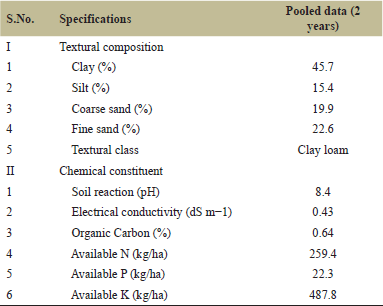 | Table 1. Physico-chemical properties of the experimental site. [Click here to view] |
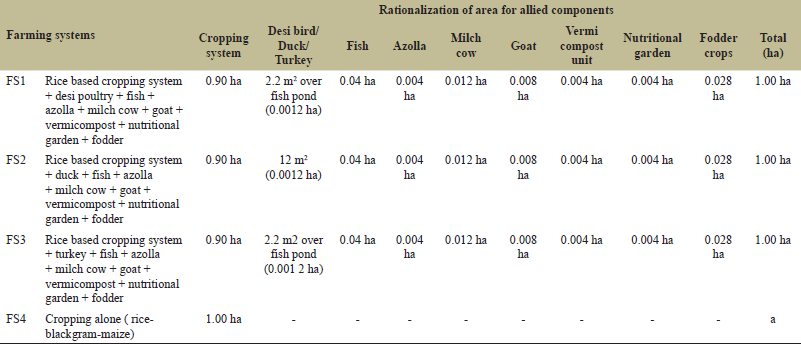 | Table 2. Land area allocation for different components of IFSs. [Click here to view] |
The total quantity of produce obtained from each component is converted as rice grain equivalent yield by working out the ratio between the total economic outcome from each component and the cost of rice/kg [7].
System profitability was determined through economic parameters like costs, total and net revenue, and daily profitability for each aspect of crop production. Labor inputs for different activities were measured in man-days per hectare per year. A man or woman working 8 hours daily was defined as one man-day. The energy value of numerous inputs was assessed [8], and the total energy of all constituents was figured. The energy expenditure (megajoules) for different inputs in crop production and associated activities was calculated, and the energy efficiency (energy ratio) was calculated using the given formula.
IFSs research utilizes non-replicated trial designs. IFS involves intricate interactions between various components such as crops, livestock, and recycling elements. Replicating entire systems can be impractical and expensive due to: Land limitations and higher initial cost of production. The primary goal is often to compare the overall performance of different IFSs rather than statistically proving small differences between specific treatments. However, non-replication comes with limitations. Without replication, it’s harder to determine if observed differences between systems are due to the treatment effect or simply random variation. Results might not be applicable to other contexts with different soil types, climates, or management practices. However, mitigation strategies includes conducting the same IFS design across various farms with different environmental conditions to increase the generalizability of findings. Multiple location trials and utilize larger plots to capture a wider range of spatial variability within the field. Analyzing non-replicated data, a two-part design allows researchers to isolate the impact of specific components within an integrated system: compares the overall productivity of different IFSs (FS1, FS2, and FS3) against a control (cropping alone - FS4). Assessing the impact of individual components involves isolating the effect of specific components within the system. By comparing systems with and without a particular component, researchers can determine its contribution to overall productivity. For instance, comparing FS1 (with desi poultry) to FS4 (without poultry) can reveal the impact of poultry on the system’s performance. This study utilizes the non-replicated designs with a two-part statistical analysis, IFS research can generate valuable insights while acknowledging the limitations. This approach helps farmers make informed decisions about adopting specific IFS practices.
3. RESULTS
A study was formulated to evaluate the best combination of components among desi poultry, turkey, duck, fish, azolla, milch cow, goat, vermicompost, nutrition garden, and fodder crops with cropping as base activity in comparison with cropping alone under lowland were carried out for 2 years.
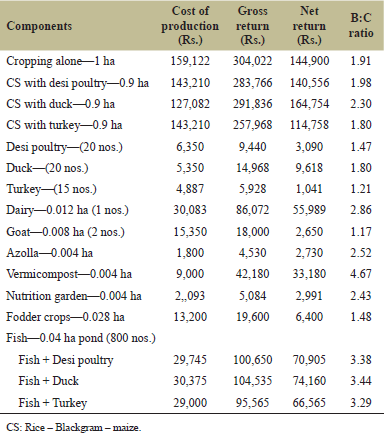 | Table 3. Economic analysis (Rs.) of individual components in IFSs. [Click here to view] |
3.1. Productivity
The output of each crop and related components within the integrated systems was converted into an equivalent rice grain yield based on their respective market values. The highest productivity of 40,332 kg rice grain equivalent yield was obtained by the (FS2). The contribution of cropping activity was 45.16%, duck (2.58%), fish (19.81%), milch cow (13.23%), goat (6.51%), and vermicompost (10.36%). Among all treatments, cropping alone had the lowest productivity, with a rice grain equivalent yield of 18,569 kg (Fig. 3).
FS2 produced 3.80% and 11.22% higher productivity than (FS1) and (FS3), respectively.
3.2. Economics
The highest gross, net, per day return and benefit-cost ratio of Rs. 651,346, Rs. 434,554, Rs. 1,191, and 3.00, respectively, were obtained by FS2 (Table 3). The lowest gross, net, and per day return and benefit-cost ratio were obtained with cropping alone (FS4) (Fig. 1).
3.3. Employment Generation
While the cropping system alone offered 359 days of labor per hectare per year, the FS2 system provided the most employment opportunities at 789 days per hectare per year, with the cropping system contributing 40.93%, 16.98% from duck components, 3.04% from fish and 0.89% from azolla, 15.08% from milch cow, 11.90% from goat, 3.29% from vermicompost, 2.41% from nutrition garden, 5.44% from fodder crops. The fish component generated an employment opportunity of 24 man days/ha/year, whereas the duck component generated an employment opportunity 134 man days/ha/year and milch cow generated an employment opportunity for 119 man days/ha/year. Additional employment of 430 man days generated from IFS accounting for 54.49% of total employment generation of 789 man days provided an opportunity for the employment of family labor (Fig. 4).
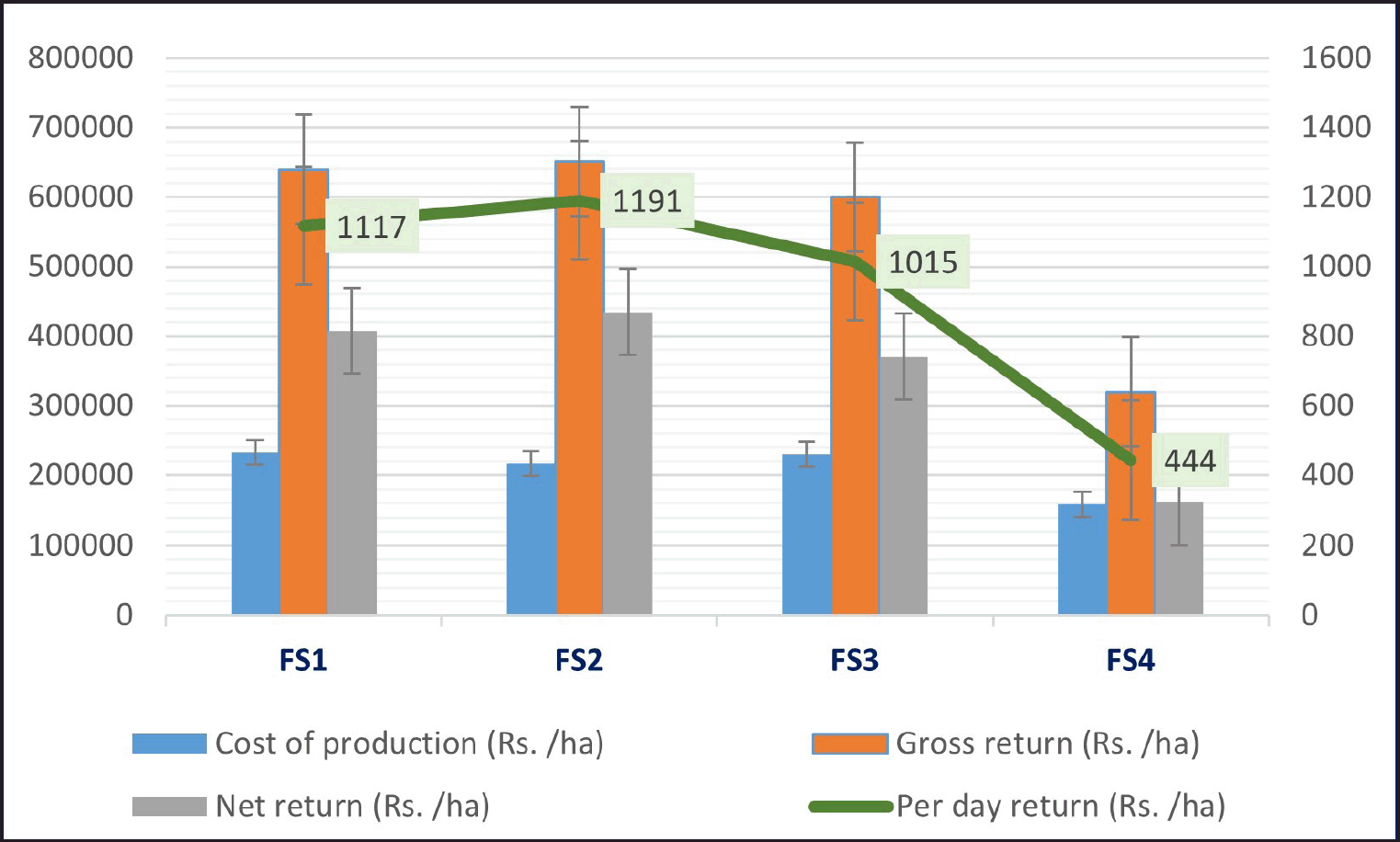 | Figure 1. Economic analysis of IFSs. [Click here to view] |
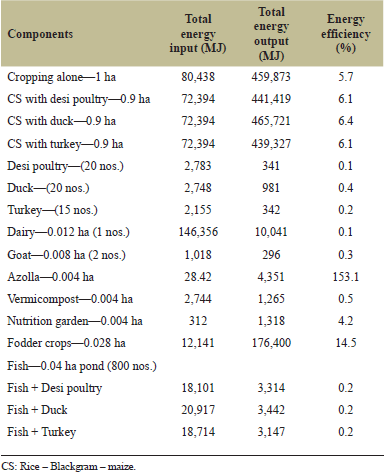 | Table 4. Total input and output energy (MJ) of individual components in IFSs. [Click here to view] |
3.4. Energy Budgeting
The energy of each input and produces was computed by using a specific energy coefficient derived by the energy mass equation and expressed in terms of MJ (Table 4).
3.4.1. Total input energy
In general, the cropping system used more energy than other components included in farming systems. Likewise, in all IFS models, among the enterprises included, the energy required to produce dairy was higher 134,006 MJ. Similarly nutritional gardens produced lower energy of 165 MJ. Among the various farming systems, FS1 was exploited higher energy (275,877 MJ) with a contribution of crop (72,394 MJ), desi poultry (2,783 MJ), fish (18,101 MJ), milch cow (146,356 MJ), goat (1,018 MJ), vermicompost (2,744 MJ) and fodder crops (12,141 MJ) than other farming systems adopted (Fig. 2). Whereas, FS2 required lower energy (228,658 MJ). Lesser energy (80,438 MJ) was used in FS4
3.4.2. Total output energy
Among the different components included in farming systems, higher output energy is obtained from crops followed by fodder crops and dairy. The dairy component contributed a major share among all the components in the farming system. Higher output energy (663,815 MJ) was obtained in FS2 compared to other IFS models. Comparatively, a lower output energy of 459,873 MJ was accounted for in FS4. In energy efficiency, FS4 recorded a higher efficiency 5.72%. It was followed by FS2 system with an energy efficiency of 2.57%.
 | Figure 2. Energy budgeting of IFSs. [Click here to view] |
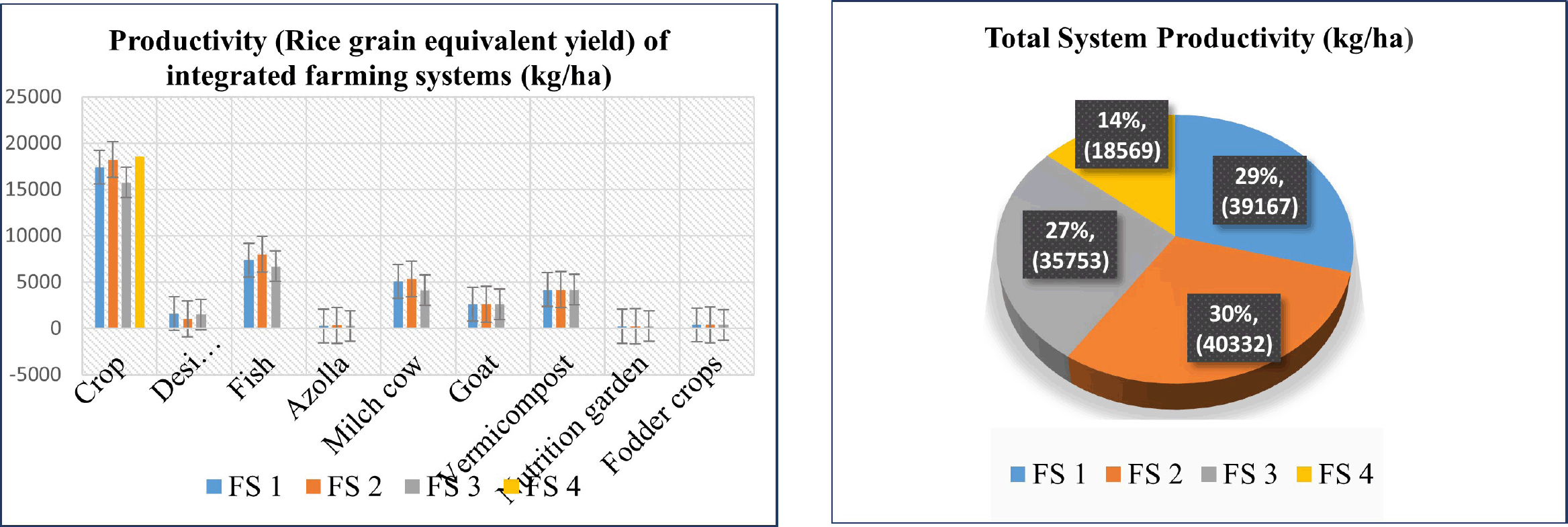 | Figure 3. Productivity (rice grain equivalent yield) of individual components and total system productivity of IFSs. [Click here to view] |
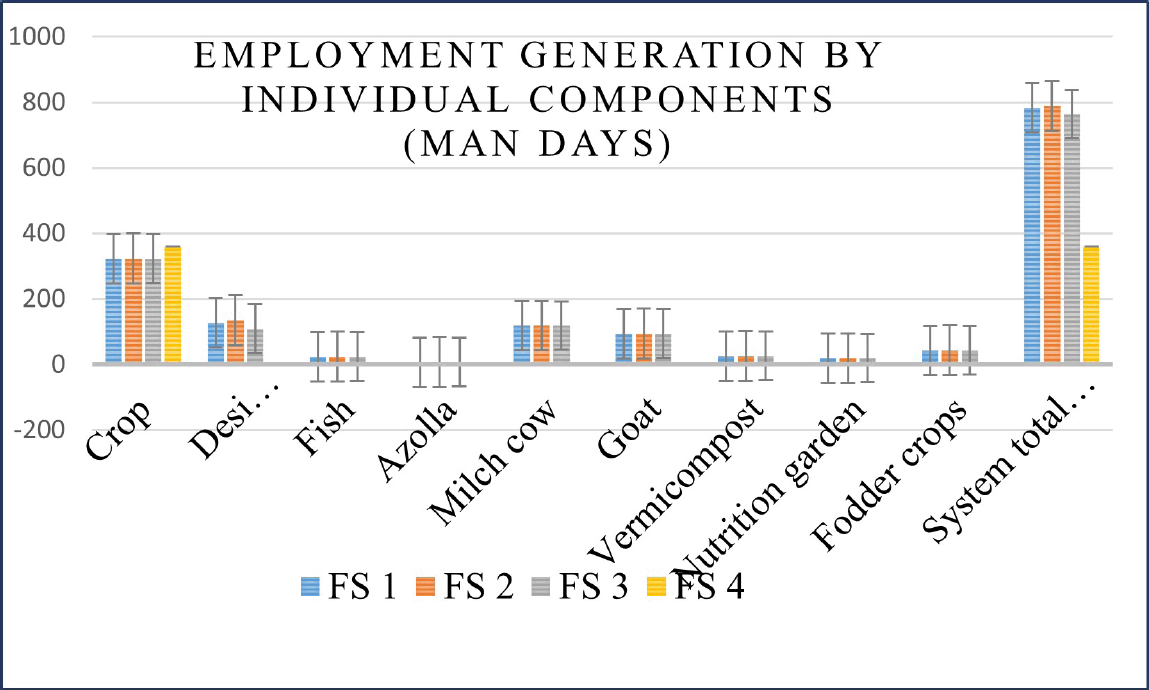 | Figure 4. Employment generation of IFSs. [Click here to view] |
4. DISCUSSIONS
4.1. Productivity of Components in the IFS
An IFS model involving different enterprises was envisaged to evaluate the best model for an area of 1 ha to recommend for the farmers of lowland ecosystems. Among the different components, cropping systems were the base activity in an IFS. The FS2 contributed 217.20% higher productivity than the cropping system. This was due to the additional economic produce obtained from duck + fish + azolla + milch cow + goat + vermicompost + nutrition garden + fodder crops. The application of recycled poultry dropping as pond silt and organic fertilizers from the affiliated enterprises may have positively influenced crop yields in the IFS, leading to increased net income, benefit-cost ratio, and daily returns. These findings align with the results of [9] and [10], which previously reported higher productivity and economic benefits in irrigated upland IFSs of Tamil Nadu.
Fish components fetched higher productivity followed by milch cow, goat, desi poultry, duck, turkey, and vermicompost components during both years of experimentation and also produced higher income, employment generation, and residue addition with the least production cost. The rice bran, maize flour, azolla, fodder, rice straw, and blackgram haulm were utilized by livestock and poultry components. Recycling these products might have reduced the production cost of milk and poultry components. The advantage of effective recycling of vermicompost as a source of nutrients for crops and bird dropping as fish feed paved a wider scope for the inclusion of bird and dairy as a component in wetland farming systems. The economic advantages of dairy components in irrigated areas [11] are concomitant to the present finding. Furthermore, bird components viz., desi poultry, duck, and turkey provided a greater share of productivity, income, employment generation, residue addition, and energy budgeting under lowland IFSs. The major inputs viz., rice bran, maize grain, azolla, and poultry dropping were obtained from crop components and poultry enterprise, respectively. Crop waste and poultry droppings were used as feed resources for animal, poultry, and fish units in the farming system resulting in minimizing the production cost and increasing the returns [12]. India is considered as land of ducks, especially Indian runner ducks are cheaper to maintain with an egg production capacity of 220 eggs/year/bird and play a vital role in balancing diet. Due to this synergism duck + fish apportioned 22.86% to the total system productivity in which crop, goat, and dairy also integrated. Crop activity shared 46.12% of total productivity due to better crop management practices [13].
Likewise in crop + fish + duck system, crop + fish + turkey and crop + fish + poultry integrated system, utilized poultry and turkey droppings of fully built-up poultry litter were recycled into fish pond with the fish contribution of 19.25%, 20.23%, and 20.17% to total productivity of desi poultry, duck and turkey. Sheltering of flock above the pond aided to fall droppings in pond directly and is deferred on the days when algal bloom appears in the pond. A simple modification of the pond system and use of locally available inputs could be used to improve both vegetable production and the income of farm households. The higher system productivity in rice + fish + duck culture under lowland ecosystem. A goat unit comprising of six Tellicherry goats was maintained for integration in the farming systems. The contribution of the goat unit to the farming system in terms of productivity and profitability was found to increase over the years [14,15]. Higher net return was produced during the second year owing to a greater rate of multiplication and meat production. From the results obtained in the study, it could be stated that goatary is a highly suitable component to small farmers as the initial investment is less [16].
The addition of manures to crops recorded higher productivity and profitability by supplying essential plant nutrients for crop growth. Augmentation of soil productiveness through the integration of livestock and poultry components for nutrient recycling and enrichment of soil [17]. The aggregate amount of organic matter collected from livestock components (milch animal and goat) of the IFS was 24,506 kg which were used as raw materials for vermicomposting. About 18,803 kg of vermicompost were produced annually in the system and were used as inputs for crop components at the rate of 5 t/ha to improve crop productivity [18].
The pond’s embankment was effectively used to cultivate vegetables year-round, providing a valuable supplement for resource-limited small farmers. This innovative approach not only ensured a steady supply of vegetables for family consumption but also generated additional income through sales. The positive impact on both nutrition and income was particularly significant for farmers with limited resources [19].
4.2. System Profitability in IFS
Profitability is mainly determined by the cost of produce obtained from various components of IFS. Efficiency of component integration was identified based on revenue generation over the years and through efficient resource recycling and management. Cost of input for each component is reduced by scientific and integration of enterprises through understanding the bio physical phenomenon in between crop and allied components. The higher cost of production of Rs. 232,230 was recorded under FS1. Higher gross and net return of Rs. 651,346 and Rs. 434,554 per hectare was recorded under FS2 (Fig. 1). Higher productivity from cropping systems, higher fish and goat meat, milk yield from dairy unit, more number of eggs from duck component and fruits and vegetables from nutrition garden sold in the market might have increased the gross and net return under FS2. This system was found to be the best income-generating farming system among the different farming systems evaluated. An IFS model consisting of field crops, horticultural crops, vermicompost, and poultry components enhanced the productivity, net monetary returns, and benefit-cost ratio as compared to the conventional farming system is in support of the present finding [20]. Crop cum dairy farming systems were superior in generating higher net returns [11]. Higher income in dairy and poultry-based farming systems than cropping alone [21].
Higher benefit cost ratio of 3.00 was recorded under FS2. It might be due to the low amount of total cost involved in duck + fish + azolla + milch cow + goat + vermicompost + nutrition garden + fodder crops than the other treatment. The per day return recorded was higher Rs.1,191 under FS2 compared to another farming system. This was due to higher income obtained from crops, duck, fish, dairy, goat, vermicompost, and nutrition garden components. Integration of the cropping system with dairy and allied enterprises increased the per day return compared to cropping alone [22].
4.3. Employment Generation in IFS
In spite of employment generation in agriculture sector grows significantly at a slower rate, potentially not being fully exploited. Engagement of laborers in crop activities meant for occasions while allied enterprises in the farming system create opportunity for year round employment. The purpose of increasing employment opportunities is not only meant for increasing man days per year but also to have a uniform spread round the year to make use of family labors of small and marginal category farmers effectively. The cropping system with the integration of livestock, poultry, and fish components provided higher employment opportunities for family labor. FS2 farming system provided higher employment opportunities of 789 man days/ha/year with a contribution of 323 man days from the cropping system, 134 man days from duck component, 24 man days from fish component, 7 man days from azolla component, 119 man days from milch cow component, 94 man days from goat component, 26 man days from vermicompost component, 19 man days from nutrition garden, and 43 man days from fodder crop component (Fig. 4). Livestock and bird components created employment throughout the years, which can be effectively met with the available family labor. Such higher employment generation in lowland IFSs [23]. Generation of employment further makes the dairy component a positive linkage in the IFS. Dairy and poultry rearing recorded assured, constant income on day one itself and provided nutritional security to the family members.
4.4. Energy in IFSs
IFS presents a promising pathway to sustainable agriculture by promoting resource efficiency and reducing reliance on external inputs. Energy sustainability is a crucial aspect of IFS, as it involves minimizing energy consumption while maximizing energy production. Crop residue and livestock manure can be used to generate bioenergy through processes of composting. The FS2 farming system has resulted in the highest energy output of 658,036 MJ/ha with an energy efficiency of 2.83%. The energy value of milk, desi poultry, duck, turkey, and goat meat was 4.90, 8.11, 7.56, 9.66, and 4.94 MJ as against 14.7 for rice/blackgram/ maize grains. The energy in cropping systems with fish, poultry, dairy, goat, and vermicompost component systems was effectively utilized as compared to another system. The potential of animal-crop integration to enhance energy yield and improve energy utilization efficiency [24,25].
4.5. Practical Challenges for Adoption of IFSs
IFSs propose a favorable practice for sustainable agriculture, but their adoption faces several practical challenges. The following are some of the key obstacles.
1. Lack of technical knowledge and expertise, IFS often involves complex interactions between different components (e.g., crops, livestock, and aquaculture) requiring specialized knowledge and skills. Many farmers may lack the necessary expertise to manage these systems effectively. The limited availability of training programs and extension services can hinder knowledge transfer [25].
2. High initial investment, setting up IFS often requires significant investments in infrastructure, such as livestock sheds, poultry sheds, fish ponds, fencing, processing units, and specialized equipment for various components of the system can be expensive. The cost of feed, fertilizers, and other inputs can be substantial, especially in the early stages. Managing an IFS can be labor-intensive, especially during peak seasons. Many farmers may lack access to credit or other financial resources to cover these costs [26].
3. Market risks and price fluctuations, prices for agricultural commodities can be highly volatile, affecting the profitability of IFS. While IFS can help diversify income sources, they may still be vulnerable to market fluctuations. Finding suitable markets for diversified products can be difficult, especially in rural areas [27].
4. Environmental and ecological constraints, IFS may require more land than conventional farming practices, which can be a limitation in areas with limited land resources. Poor soil quality can limit crop productivity and livestock health. Balancing the needs of different components within an IFS can be challenging, especially in terms of water, nutrients, and pest control. Climate change poses additional risks to IFS, such as extreme weather events and changes in crop patterns [28].
5. Social and cultural barriers, many farmers may be reluctant to adopt IFS due to cultural or social norms. Changes in farming practices can sometimes face resistance from local communities. Building trust and facilitating knowledge sharing within communities can be essential for successful IFS adoption [29].
Addressing these challenges will require a multifaceted approach, including: Technical assistance by providing training and extension services to farmers, financial support by offering subsidies, loans, and credit facilities, market development by promoting market access for IFS products, policy reforms by creating favorable policies and regulations for IFS adoption and community engagement by fostering collaboration and knowledge sharing among farmers. By overcoming these challenges, IFS can play a vital role in promoting sustainable agriculture and improving the livelihoods of farmers.
The true impact of IFS often requires long-term studies due to factors like soil fertility changes and variations in weather patterns. To overcome this, it requires long-term studies which can be expensive and require sustained commitment. Capturing the full economic picture of an IFS can be complex. Factors like labor requirements, market fluctuations for diverse products, and potential cost savings from resource recycling need to be considered. Encouraging farmers to adopt unfamiliar IFS practices requires addressing concerns about initial investment costs, required skill sets, and potential risks associated with changing established methods.
4.6. Future Research Directions
1. Modeling and simulation: Develop dynamic models that capture the complex interactions between various components of IFS, including crops, livestock, and the environment. Conduct scenario analysis to evaluate the potential impacts of different climate change scenarios, policy changes, and market fluctuations on IFS performance. Utilize spatial modeling techniques to identify suitable locations for IFS implementation based on factors like soil quality, water availability, and market access. Develop economic models to assess the profitability and economic sustainability of IFS under different conditions.
2. Socio-economic studies: Explore farmers’ perceptions of IFS, including their attitudes, beliefs, and motivations for adoption. Analyze the role of social networks and community dynamics in influencing IFS adoption and sustainability. Conduct economic feasibility studies to identify the factors that influence the profitability of IFS for farmers. Evaluate the impact of government policies and regulations on IFS adoption and implementation.
3. On-farm participatory research: Work closely with farmers to develop IFS practices that are tailored to their specific needs and local conditions. Foster knowledge co-production between researchers and farmers to generate practical and relevant insights. Promote community-based research to empower farmers and enhance their participation in decision-making. Implement adaptive management strategies to allow farmers to adjust their IFS practices in response to changing conditions.
4. Long-term monitoring: Assess the impact of IFS on ecosystem services, such as carbon sequestration, biodiversity conservation, and nutrient cycling. Monitor changes in soil health indicators, including organic matter content, microbial activity, and nutrient availability. Track the long-term economic performance of IFS, including profitability, income diversification, and risk management. Evaluate the resilience of IFS to climate change, market fluctuations, and other external shocks.
5. Farmer training programs: Develop comprehensive training programs that cover the technical, economic, and social aspects of IFS. Provide hands-on training in practical skills, such as livestock management, crop production, and resource conservation. Equip farmers with problem-solving skills to address challenges that may arise during IFS implementation. Promote continuous learning through workshops, field visits, and online resources.
6. Interdisciplinary collaboration: Encourage interdisciplinary collaboration among researchers from various fields, including agronomy, ecology, economics, sociology, and engineering.
7. Global knowledge exchange: Facilitate the exchange of knowledge and experiences related to IFS between different countries and regions.
8. Policy analysis: Conduct research on the role of policy frameworks in promoting or hindering IFS adoption and development.
By pursuing these research directions, we can advance our understanding of IFS and develop effective strategies for promoting their adoption and sustainability.
5. CONCLUSION
This study highlights the significant benefits of adopting a rice–blackgram–maize cropping system integrated with various livestock and resource recycling activities in one ha under lowland conditions of Tamil Nadu. It significantly improves productivity, economic gains, job creation, energy efficiency, and environmental sustainability by incorporating a rice–blackgram–maize cropping system on 0.9 hectares along with additional integrated activities with an area of 0.1 ha. These activities include: Raising 20 ducks over a fish pond stocked with 800 fingerlings for polyculture in a 0.04-hectare pond, Cultivating 0.004 hectares of azolla, Keeping 1 dairy cow and 2 adult goats, Producing 5.0 tonnes of vermicompost annually using residue from the other components, Maintaining a small, nutrient-rich garden on the fish pond embankment (0.004 hectares) and growing 0.028 hectares of fodder crop to feed the goats and cattle. This combined approach promotes a more efficient and sustainable farm ecosystem. By following these recommendations, farmers can transform their land into a more productive, economically viable, and environmentally friendly agricultural system.
6. ACKNOWLEGMENTS
The authors acknowledge the Tamil Nadu Agricultural University, Coimbatore, for the facilities provided.
7. AUTHOR CONTRIBUTIONS
All authors made substantial contributions to conception and design, acquisition of data, or analysis and interpretation of data; took part in drafting the article or revising it critically for important intellectual content; agreed to submit to the current journal; gave final approval of the version to be published; and agree to be accountable for all aspects of the work. All the authors are eligible to be an author as per the International Committee of Medical Journal Editors (ICMJE) requirements/guidelines.
8. FUNDING
There was not any external support for this study from any public or private organizations.
9. CONFLICTS OF INTEREST
The authors report no financial or any other conflicts of interest in this work.
10. ETHICAL APPROVALS
This study does not involve experiments on animals or human subjects.
11. DATA AVAILABILITY
The corresponding author can provide the datasets acquired and/or analyzed during the current work upon reasonable request.
12. PUBLISHER’S NOTE
All claims expressed in this article are solely those of the authors and do not necessarily represent those of the publisher, the editors and the reviewers. This journal remains neutral with regard to jurisdictional claims in published institutional affiliation.
13. USE OF ARTIFICIAL INTELLIGENCE (AI)-ASSISTED TECHNOLOGY
The authors declares that they have not used artificial intelligence (AI)-tools for writing and editing of the manuscript, and no images were manipulated using AI.
REFERENCES
1. Singh JP, Gangwar SA, Kochewadi SA, Pandey DK. Integrated farming system for improving livelihood of small farmers of western plain zone of Uttar Pradesh, India. SAARC J Agric 2012;10(1):45–53.
2. GOI. Agricultural statistics at a glance, Directorate of Economics and Statistics. Govt. of India, New Delhi, India, 2021. Available via https://desagri.gov.in
3. Siddeswaran K, Sangeetha SP, Shanmugam PM. Integrated farming system for the small irrigated upland farmers of Tamil Nadu. In Extended summaries: 3rd International Agronomy Congress, 2012 Nov 26–30, New Delhi, India, Vol. 3, pp 992–3, 2012.
4. Gill MS, Singh JP, Gangwar KS. Integrated farming system and agriculture sustainability. Indian J Agron 2009;54(2):128–39.
5. Gangwar B. Farming systems research for accelerating agricultural development in less developed countries—a review. Agric Rev 1993;14(3):149–59.
6. Lal M, Patidar J, Kumar S, Patidar P. Different integrated farming system model for irrigatedcondition of India on basis of economic assessment: a case study: a review. Int J Chem Stud 2018;6(4):166–75.
7. Singh JP, Salaria A, Singh K, Gangwar B. Diversification of rice-wheat cropping system through inclusion of Basmati rice, potato and sunflower in trans-gangetic plains. J Farming Syst Res Dev 2005;11(4):12–8.
8. Devasenapathy P, Senthilkumar G, Shanmugam PM. Energy management in crop production. Indian J Agron 2006;54(1):80–90.
9. Kumar S, Subhash N, Shivani S, Singh SS, Dey A. Evaluation of different components under integrated farming system (IFS) for small and marginal farmers under semi-humid climatic environment. Exp Agric 2012;48(3):399–413.
10. Sivamurugan. Sustainable farming systems under irrigated upland situation. Ph.D. Dissertation, TNAU, Coimbatore, India, 2001.
11. Jayanthi C, Vennila C, Nalini K, Chandrasekaran B. Sustainable integrated management of crop with allied enterprises. Sustain Agric Special Feature 2009;2(1). 1–7.
12. Jayanthi C, Baluswamy M, Chinnusamy C, Mythily S. Integrated nutrient supply system of linked components in lowland integrated farming system. Indian J Agron 2003;48(1):241–6.
13. Renuka P. Evaluation of crop establishment techniques and geometries combined with recycled nutrient sources in rice based integrated farming system under periyar-vaigai command area. Ph.D. Thesis, Tamil Nadu Agricultural University, Coimbatore, India, 2017.
14. Channabasavanna AS, Biradar DP. Rice-fish poultry system model for rice growing farmers of Karnataka. Indian Farming 2007;57(5):20–2.
15. Jayanthi C, Vennila C, Nalini K, Vivek G. Physical indicators on farm farming system for irrigated uplands of Western zone of Tamil Nadu. J Farming Syst Res Dev 2007;13(1):17–25.
16. Radhamani S. Sustainable integrated farming system for dryland vertisol areas of Western Zone of Tamil Nadu. Ph.D. Dissertation, Tamil Nadu Agricultural University, Coimbatore, India, 2001.
17. Murugan P. Evolving suitable integrated farming system model for irrigated upland of north eastern zone of Tamil Nadu. Ph.D. Thesis, Tamil Nadu Agricultural University, Coimbatore, India, 2015.
18. Baishya A, Borah M, Gogoi B, Hazarika J, Bora A, Rajbongshi A, et al. Waste recycling through integrated farming system—an Assam Agriculture experience. Book of Abstracts, Ramiran, 2015. In 16th International; Conference Rural-Urban Symbiosis, Hamburg, Germany, 2015, p 170.
19. Alam MR, Ali MA, Hossain MA Molla MSH, Islam F. Integrated approach of pond based farming systems for sustainable production and income generation. Bangladesh J Agric Res 2009;34(4):577–84.
20. Mohanty D, Patnaik SC, Jeevan Das P, Parida NK, Nedunchezhiyan M. Integrated farming system for sustainable livelihood: a success story of a tribal farmer. Orissa Rev 2010;4(2).1–3.
21. Tripathi H, Tomar SS, Pandey R, Solanki VS, Singh R, Meena KL, et al. Economic feasibility of integrated farming system models with respect to productivity and economics. In 22nd national seminar on “role of extension in integrated farming systems for sustainable rural livelihood”, Dec 9th–10th, India, 2010, pp 42–3.
22. Ramasamy C, Natarajan S, Jayanthi C, Suresh Kumar D. Intensive integrated farming system to boost income of farmers. In Proceedings of 32nd IAUA vice chancellors annual convention on Diversification in Indian Agriculture, Birsa Agricutural University, Dec 20–21, Ranchi, India, 2007, pp 28–47.
23. Ramasamy C, Natarajan S, Jayanthi C, Kumar DS. Intensive integrated farming system to boost income of farmers. In Paper Presented in the 32nd IAUN VC?s Annual Convention, RAU, Ranchi, India.
24. Channabasavanna AS, Biradar DP, Prabhudev KN, Hegde M. Development of profitable integrated farming system model for small and medium farmers of Tungabhadra project area of Karnataka. Karnataka J Agric Sci 2009;22(1):25–7.
25. Kumar A, Singh S. Challenges and opportunities of integrated farming system in India. Int J Curr Microbiol App Sci 2021;10(08):3585–91.
26. Al-Masri RA. Challenges facing integrated farming systems in Jordan. J Agric Technol 2022;18(2):339–50.
27. Singh SK, Kumar A. Challenges and opportunities of integrated farming system in India. Int J Agric Sci 2021;13(11):3354–61.
28. Wang Y, Liu J. Challenges and opportunities of integrated farming systems in China. J Agr Sci Tech 2023;5(1):1–12.
29. Sharma P, Singh B. Challenges and opportunities of integrated farming system in India. Int J Agric Econ Rural Dev 2022;11(1):1–10.